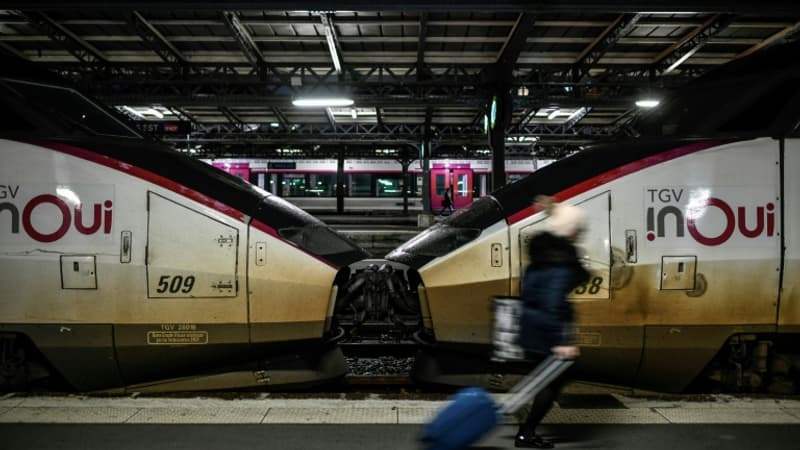This is an observation made by many French people: the price of train tickets, in particular the TGV, are getting higher and higher. The increase is particularly strong this summer when the bill is high for the most sought-after destinations with one-way tickets that can reach three figures. To the point that sometimes the plane is cheaper for the same destination, a shame.
Rate inflation is a statistical reality. Each month, INSEE calculates it over a year for the rail transport sector (as for all sectors of activity). In June 2023 it averaged +8.2% versus +8.4% a month earlier. Which is considerable because it is an average.
Above all, this inflation has in fact been taking place since July 2021, month after month, with average annual increases of over 6% and even peaks of over 14% as in April 2022 (+14.6% in one year) or in June from the same year with +14.9% over a year.
battle of numbers
The SNCF strongly questions these figures. His main argument is to claim that Insee is based on gross prices from its SNCF Connect app, prices that do not take into account discount cards, in particular the Advantage card in the hands of 5 million households. In short, for SNCF, INSEE is not based on what consumers actually pay in the end when the various reductions are applied.
The operator claims that, overall, this summer, 1 in 2 tickets sold costs less than 45 euros and that 1 in 2 Ouigo tickets sells for less than 25 euros. A statement that cannot be verified.
The SNCF also recalls that it applied “on average” this year a 5% increase in the price of TGVs, in order to absorb part of the increase in its electricity bill. He considers that he is implementing “a tariff shield” because if he transferred all the increase in his costs to his prices, the increase would be almost 13%.
Thus, it explains that the minimum prices of TGV and TGV Ouigo (accessible as soon as reservations are opened for a certain period) have not increased, nor have the price tables ouigo (1 TGV out of 5).
Higher fares due to lack of trains
However, customer sentiment is very different and the INSEE figures are a factual indicator. This feeling is mainly the consequence of the policy of Performance management applied by the SNCF that is part of a logic of supply and demand.
Thus, the price of a seat varies according to the date, the request, the occupation of the train at the time the reservation is made. Like on airplanes. Therefore, a seat for a desired destination, over a weekend, reserved late will be charged at the maximum. Its price can be three times higher than the same place booked well in advance for an early morning departure on weekdays.
The SNCF insists on repeating it: the key to the low price is maximum anticipation and the use of an Avantage card.
I still need to find space. Because the SNCF is facing a problem for the rich. The appetite for trains is only increasing, but its TGV fleet is the same (about 400 trains) as it was before the covid crisis. Worse yet, some TGVs will run in Spain, where SNCF is doing all it can with Ouigo.
With supply less than demand at peak times, trains fill up very quickly, so prices rise even faster. Sometimes, even anticipating, the client finds himself facing prohibitive prices.
The new TGV M not before the end of 2024
Unfortunately, in the short term, we should not expect better. The brand new TGV M (which offer 20% more seats) are not expected before the end of 2024 and in a trickle, at a rate of 12 trains per year. An additional 12 Ouigo trains are also scheduled, but again, we will have to wait until 2025.
To go faster, the SNCF plans to extend the life of certain TGVs in circulation, this is the Botox project. The TGVs that were to be phased out of circulation after 35 years of good and loyal service will experience a second life by driving for another 5, 10 or even 15 years.
Enough to last up to 50 years. But for the moment, it is a project that has not yet been validated.
Competition, the only lever to lower prices
Finally, to get your hands on tickets where prices drop, you need to turn to hubs where competition exists. This is the case of the Paris-Lyon line where Trenitalia operates and soon the Spanish Renfe.
Thus, according to the Trainline platform, the fall on this line is 44%, compared to the same period in 2019. Above all, this fall is intensifying. Still in Paris-Lyon, end of 2022the decrease was 40% compared to 2019 according to a previous Trainline study.
The drop in prices on this axis is obviously due to the aggressive policy of Trenitalia, which seeks to gain market share quickly, the one-way ticket is sold from 35 euros. Therefore, the SNCF had to align or at least moderate its price increases (it still has the advantage of running many more trains per day than its competitor).
Like what, price reductions are always possible. But only when the SNCF is challenged.
Source: BFM TV


